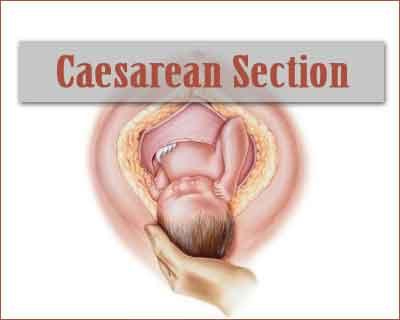- Home
- Editorial
- News
- Practice Guidelines
- Anesthesiology Guidelines
- Cancer Guidelines
- Cardiac Sciences Guidelines
- Critical Care Guidelines
- Dentistry Guidelines
- Dermatology Guidelines
- Diabetes and Endo Guidelines
- Diagnostics Guidelines
- ENT Guidelines
- Featured Practice Guidelines
- Gastroenterology Guidelines
- Geriatrics Guidelines
- Medicine Guidelines
- Nephrology Guidelines
- Neurosciences Guidelines
- Obs and Gynae Guidelines
- Ophthalmology Guidelines
- Orthopaedics Guidelines
- Paediatrics Guidelines
- Psychiatry Guidelines
- Pulmonology Guidelines
- Radiology Guidelines
- Surgery Guidelines
- Urology Guidelines
Caesarean sections births altering course of evolution

Regular use of caesarean sections to deliver babies is affecting the human evolution, according to a new study. An increasing number of mothers now need surgery to deliver a baby due to their narrow pelvis size, researchers said.
Researchers estimate cases where the baby cannot fit down the birth canal have increased from 30 in 1,000 in the 1960s to 36 in 1,000 births. Historically, these genes would not have been passed from mother to child as both would have died in labour.
According to Dr Philipp Mitteroecker from the University of Vienna, there is a long standing question in the understanding of human evolution. "Why is the rate of birth problems, in particular what we call fetopelvic disproportion basically that the baby does not fit through the maternal birth canal why is this rate so high?" he said.
"Without modern medical intervention such problems often were lethal and this is, from an evolutionary perspective, selection. Women with a very narrow pelvis would not have survived birth 100 years ago. They do now and pass on their genes encoding for a narrow pelvis to their daughters," said Mitteroecker.
It has been a long standing evolutionary question why the human pelvis has not grown wider over the years. The head of a human baby is large compared with other primates, meaning animals such as chimps can give birth relatively easily, BBC News' reported.
Researchers devised a mathematical model using data from the WHO and other large birth studies. They found opposing evolutionary forces. One is a trend towards larger newborns, which are more healthy. However, if they grow too large, they get stuck during labour, which would have proved disastrous for mother and baby, and their genes would not be passed on."One side of this selective force -namely the trend towards smaller babies has vanished due to caesarean sections," said Mitteroecker.
C-sections birthscaesarean sectionscaesarean sections birthsdeliveryDr Philipp MitteroeckersurgeryUniversity of Vienna
Source : PTINext Story
NO DATA FOUND

Disclaimer: This site is primarily intended for healthcare professionals. Any content/information on this website does not replace the advice of medical and/or health professionals and should not be construed as medical/diagnostic advice/endorsement or prescription. Use of this site is subject to our terms of use, privacy policy, advertisement policy. © 2020 Minerva Medical Treatment Pvt Ltd